June/July 2011
Tutti Okay!
We traverse the Valley of the Po River across Northern Italy
We mounted our first Italian Campaign between mid June and mid July.
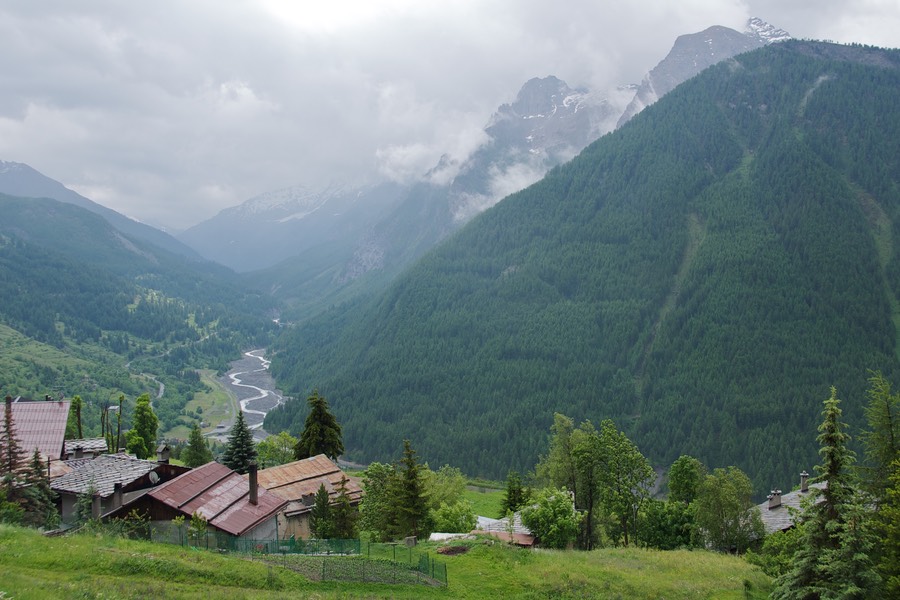
Our strategy was to work our way across the northern part of the country, with an exit into Slovenia slated for approximately mid-month. We would take no prisoners or souvenirs, would limit our gelato and pizza consumption to a reasonable level, were prepared to be charmed, and planned our visits to cities around Sundays, when the parking would be free (and more available), there would be fewer people and lighter traffic, and the churches were bound to be open. None of the WWII generals were still around, not to mention other prior invaders like Attila and Charlemagne, nonetheless we tried to maintain a military perspective and to always keep our goals in view: exploring a new area, meeting locals, eating well, and having a helluva good time. We think we’ve succeeded admirably on all fronts. And, by the way, the Italians really do talk like that – how could they manage if they had no hands!?
All told, we’ve spent about a month “in country.” It probably would have been a bit less, had we not spent a goodly amount of time waiting for some mail. But there are snags in all campaigns; we used the time to prepare for our Balkan Expedition. And, we’ve seen some awesome countryside.
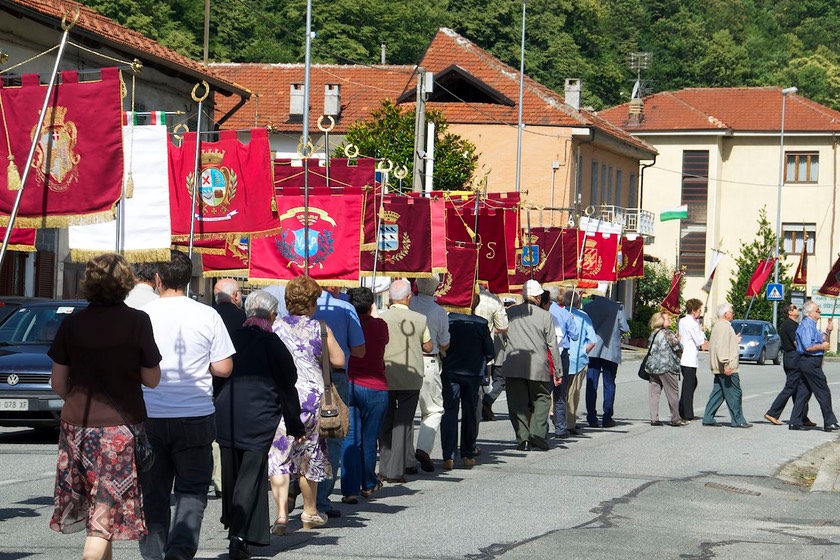
Entering Italy from the west, by way of the French Alpes-Maritimes, our first glimpses were of open farmland and small villages. They were more colorful than the typical grey-sided houses of the French countryside, and we liked the change very much. We spent our first night, a Saturday, on the edge of the small town of Porte, next to a raging river. The locals came to check on it regularly; we assumed it was higher than normal and they were interested to see it. There is a tremendous amount of water coming down out of these mountains; rivers are often muddy and right up to the top of their banks, while smaller, faster running streams are crystal clear and bubbling along.
Sunday morning we awoke to evidence of a parade forming up. We drove down the main street of Porte, but soon found our way blocked; the parade was now underway. So what do you do? You pull over and stop, get out your camera, and enjoy the show. We had already learned that 2011 is the 150th anniversary of Italy becoming a nation, but this was something else: the 50th anniversary of the founding of the local chapter of an organization called AVIS. Anyway, any excuse for a parade is fine with us and we enjoyed watching a small group of locals – both young and ancient – who were out to celebrate, complete with individual banners, a band, etc. We snapped away and then followed them to their destination, the town hall, where cookies and punch and much speechifying were on the agenda for those attending. What better way to start a bright and beautiful day!
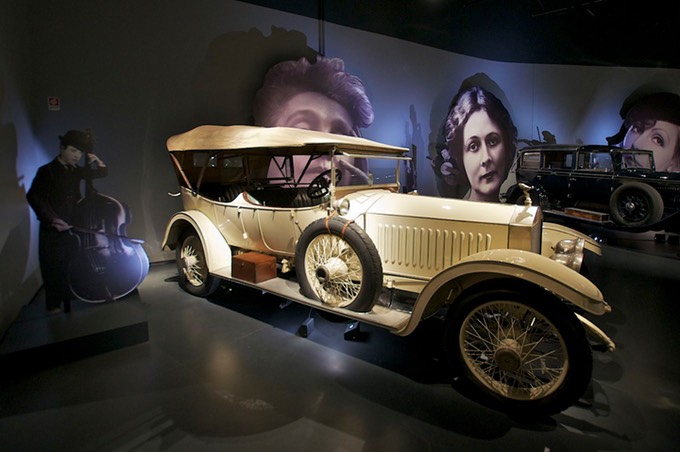
Our campaign for Italy included several stops at automotive museums, and we hopped-skipped-jumped from Torino to Brescia and on to Mantua in relatively short order, with Rick leaving large puddles of drool behind at each stop; here he is with the details. Well, Italy does cool cars and has plenty of museums reflecting the national love affair with the automobile. For this trip we limited ourselves to spots that were actually on our way, thus we bypassed the Ferrari and Ducati museums further south or the Moto Guzzi factory up on Lake Como. We will see them later. Nonetheless, we didn’t do too badly.
First stop was the Italian National Automobile Museum in Torino (Turin). Turin has long been Fiat headquarters and thus the Detroit of Italy, so this is the logical place for the museum.It is a large and elaborate affair with some very interesting thematic displays, though I found the actual car collection to be a bit lacking in star power.
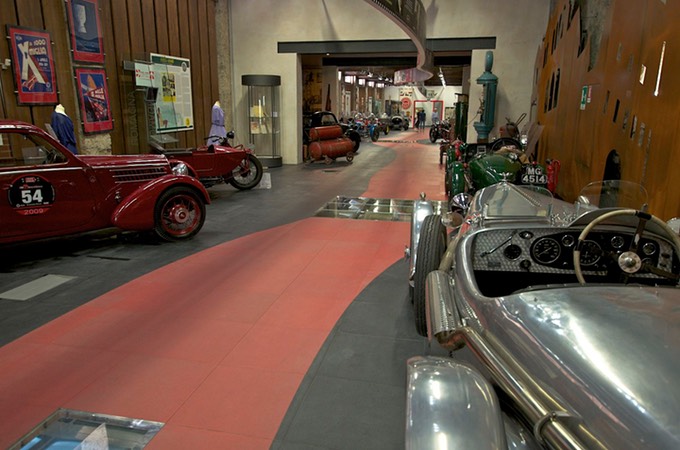
Next stop was to Brescia, home of the Mille Miglia, Italy’s 1,000-mile open road race that ran from Brescia to Rome and back from 1927-57. This was one of the highlights of the racing calendar in its day and all the greats would race in it. It now has been resurrected as a historic rally event and we hope to be able to take it in next spring. The museum focuses on the history of the event, naturally, and displays well written accounts of each year’s race along with lots of period memorabilia and plenty of cars, albeit not really top line machinery; all displayed in a lovely old monastery. Very nice.
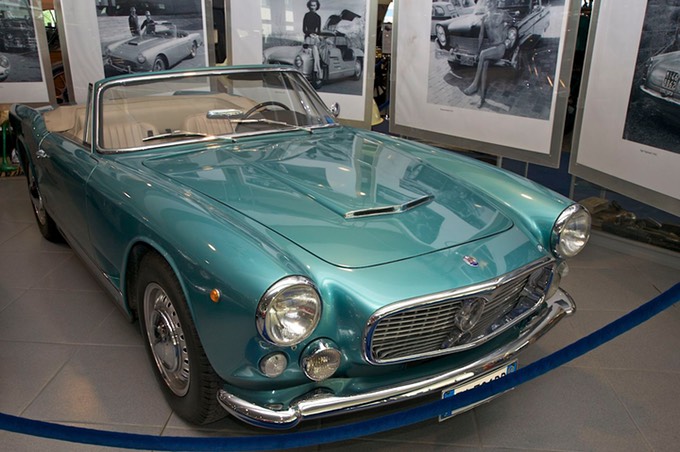
Mantua is the birthplace of Tazio Nuvolari, the unquestioned top European driver of the 20’s and 30’s. The museum dedicated to him here is a very small labor of love for the local automobile club, featuring mostly memorabilia such as cups and driving gloves, helmets and other clothing, with some photos and old video but with no cars at all. Still well worth a visit, and once again housed in a gorgeous old building right on one of the city’s main piazzas.
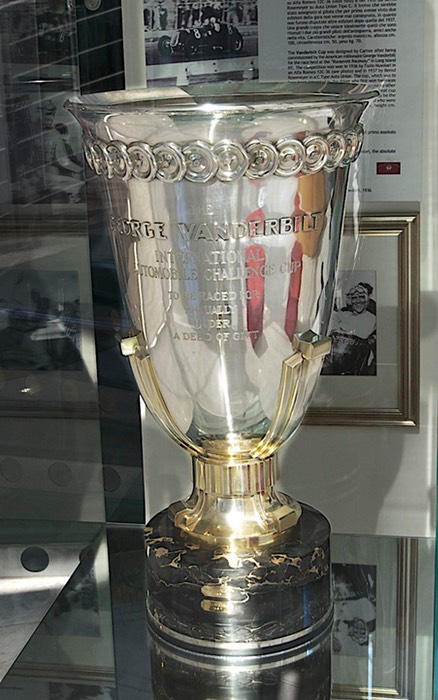
Saving the best to last, between Mantua and Verona, we just happened to pass signs for a museum we had not discovered online as we had all the others. This was the Nicolis Museum, a private collection of not only cars, but also motorcycles, bicycles and photographic equipment -- all housed in a shining new purpose-built structure in Villa Franca, just on the outskirts of Verona. The cars were in magnificent condition, and there were plenty of them.The quality and quantity of the displays was reminiscent of the Nethercutt museum we have enjoyed so much in Sylmar, California; absolutely top notch. One item I have to mention in particular. The day before at the Nuvolari museum I’d seen the cup given to the winning driver of The Vanderbilt Cup race, which Nuvolari won in 1936; it was about ten inches tall. Now, for old road racing buffs like me, The Vanderbilt Cup might as well be the Lombardi Trophy of NFL Super Bowl fame. Back in the day, meaning the teens, twenties and thirties, this race was run on Long Island, NY and all the European greats would come over to race in it; it was the biggest race in the US at the time. Well, at the Nicolis Museum they have the real thing, THE Vanderbilt Cup; I was impressed. Once again, the unplanned, unexpected, spontaneous place or event had become the highlight of our museum tour; we just love it when that happens. Our photos from each of these four museums can be seen at motor-museums.com.
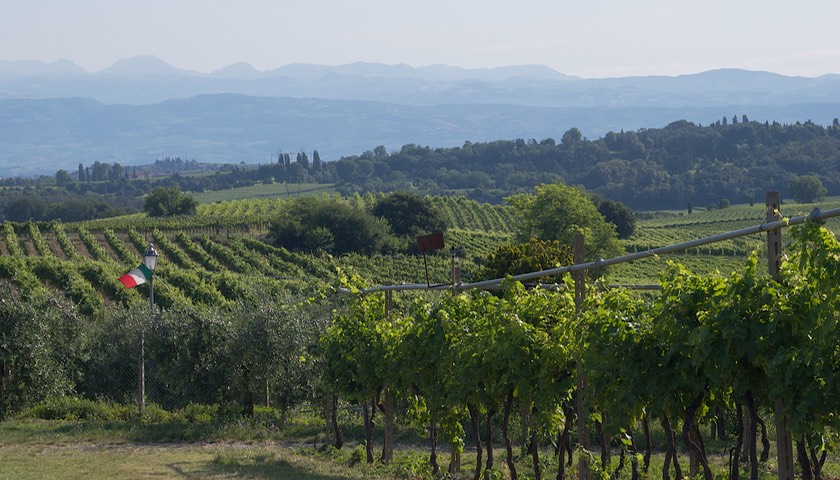
Between car museums we wandered the countryside, past gargantuan fields of corn and grapes and other crops, through zillions of tiny villages, each boasting a large campanile (bell tower) with pride of place. It got quite industrial in the city areas, with attendant air pollution and general ugliness, but in between the cities it was lovely and green and sparkly. Torino – Milano – Brescia – Mantua: this northern strip of Italy across the Po River Valley reminded us of the Sacramento-San Joaquin Delta in California. Rich farmland criss-crossed by rivers and industrial zones and plenty of grapes.
In Torino we purchased a dongle for our internet access. Not surprisingly, the store set it up improperly so we had some trouble right off the bat, but we got that fixed and TIM the Terrific has worked amazingly well ever since. The only time (knock on wood) we’ve been without coverage was one night when we stopped on top of a ridge between valleys and apparently the coverage from one side or the other didn’t get that far up the hill. The best deal from TIM was for three months’ coverage, so even though we’ll enter Slovenia long before that time passes, we intend to duck back into Italy a couple of times when we are near, so we can continue to get that excellent coverage. Also, when we return to Italy next spring we’ll reactivate TIM and bring him along.
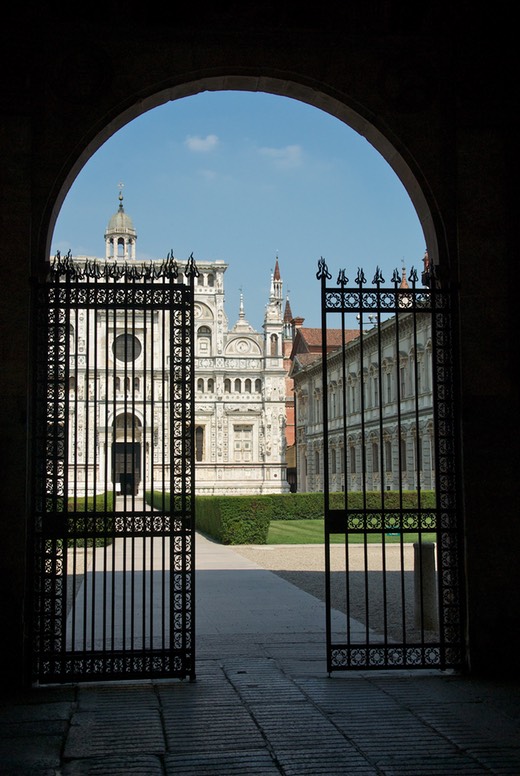
Suddenly, amazingly, we had made contact with one of the few other American couples we knew who were traveling in Europe, and we would be able to cross paths with them in Mantua in a few days. Vicki and Mark were coming in from the Venezia area, and we were delighted to be able to see them. They have spent a lot of time in Italy, and we were anxious to hear their stories, as well as just having time for hugs and giggles and an opportunity to wander Mantua with them.
Heading toward Mantua, we found time to stop at a Carthusian monastery in Certosa, which was quite impressive. No pictures inside, ‘though Rick managed a few before being reminded (friend Mark later confirmed that this is customary in northern Italy – not true in Rome or points south we were pleased to hear). Aside from the incredible paintings and statuary and great architecture, my favorite sight was of a monk walking down a hall with a can of WD40 in his hand. He stopped at a door, squirted, wiggled the doorknob, and went on, smiling. Life in the monastery, among the silent Carthusians.
The monastery had a delightful, shady parking lot for us to enjoy during our visit; this was particularly great because it was hot, very hot. This area is, of course, right off the Adriatic Sea, so there’s no saving grace of altitude to keep a body cool. For the last 3 weeks we’ve been coping with that heat – high 80s and 90s every day we’re down at low elevation.
From Certosa we traveled the few miles on to Mantua, where we almost immediately found Vicki and Mark, cruising the parking lot where we'd agreed to meet and spend the night. The lot was close to a marina, and there were a few mosquitoes, but we didn't let that stifle our fun.
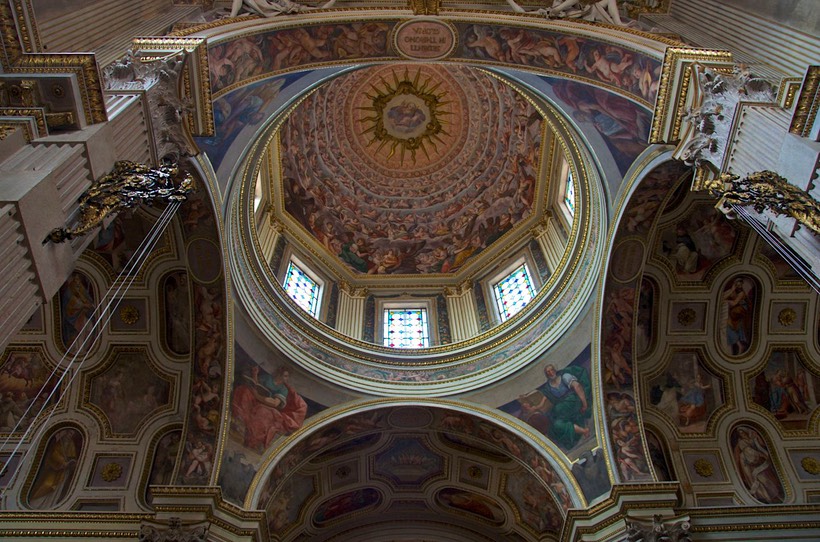
We all enjoyed Mantua very much. While Rick solved the problem with TIM, the rest of us had a chance to visit one of Mantua's most famous sights: the Palazzo Ducale. This lovely building contains Mantegna's magnificent frescoes of the Gonzaga family; it was my up-close introduction to the wonders of the Italian Renaissance, and it was very exciting, though once again photos were not allowed. It really was much too hot, however, and all of us were anxious to move on.
So, after a night and morning together, we all headed for the hills; Mark and Vicki were finishing up Italy and heading north toward Chamonix, France; we decided we would return to Mantua later, and went due north to the Dolomites to escape the heat. This was a very effective plan and we’ve mostly stayed in the mountains ever since, slowly moving further and further east as we explored this wonderful area.
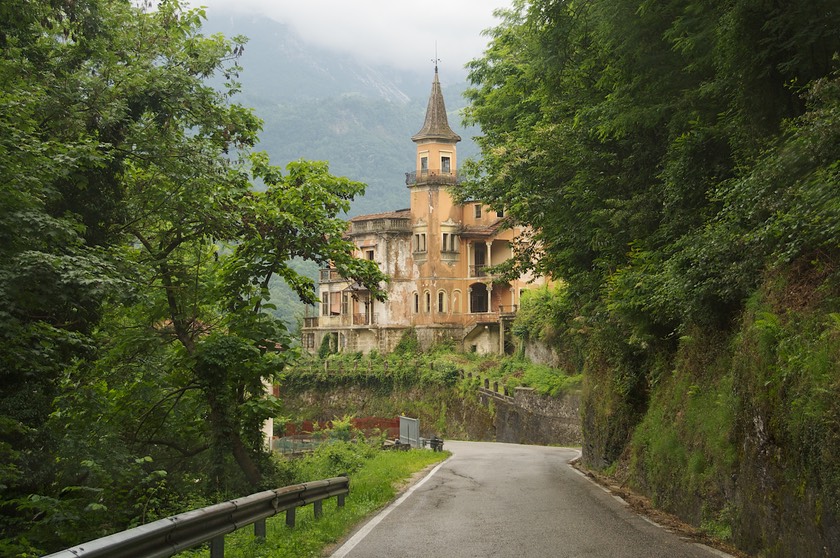
We’ve wandered here and there, following tiny winding roads through one-street hamlets clinging to the hillsides, and over passes and past herds of critters; no snow is on the ground, but there are many reminders of how the winters are spent here. We’ve parked up in meadows next to huge ski resorts; we’ve noted the enormous amount of cord wood stacked by each home waiting for next fall; and have noticed that these houses are mostly alpine chalets, with very steep roofs festooned with snow melting grids. There are also lots of snow chain signs along the roads.
Up here the hydrangeas are in bloom, and many different kinds of wildflowers in the fields. The forests are green and healthy, and although there is lots of logging going on, we haven’t seen any clear-cutting. Such a lovely area. We’ve had great luck getting cool by spotting a tiny road that goes up and and up and up; we twist and wind along with it until we find the perfect place to pull off, and there we park until we’re ready to come back down again. We expect to use this technique all summer long.
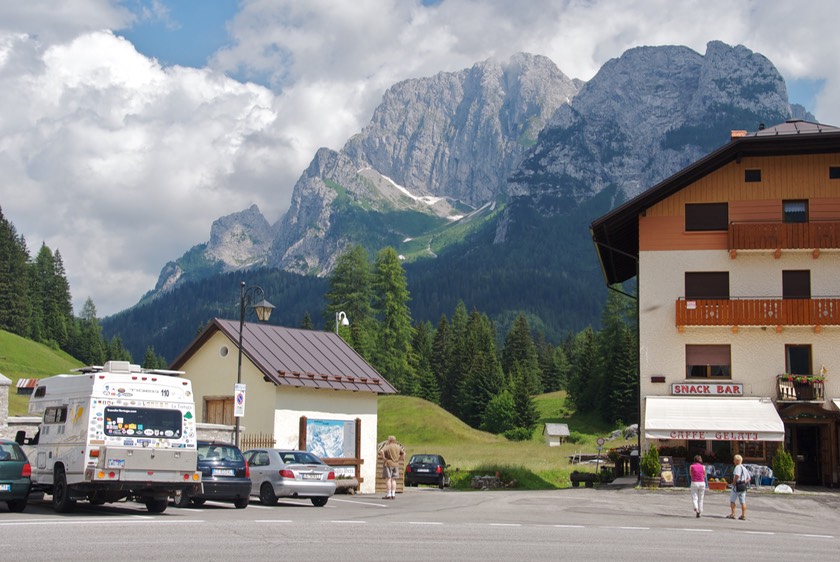
As we’ve moved further east, things have become more upscale, with summer camps (smurfs galore trooping along with matching tee shirts and caps) and vacation homes multiplying. The Italian National Ski Team shared the road with us at one point, as they practiced for the next winter’s events using poles and ski-shaped skate thingies. We spent one night near what turned out to be a very fancy biathlon practice area; again the young athletes were using the skate thingies to simulate skis, but this time stopping at the rifle range to unload a few rounds in passing. It was near here, in a charming, tiny little town that we were able to take on water from the town’s water fountain. Not a fountain like in the middle of a plaza with coins in the bottom, but just a nice sturdy stone basin with a pipe sticking out and water running. Even our Rough Guide book recommends filling your water bottles at these locations, and folks were doing just that; we just used a hose and took on twenty gallons or so to fill our water bottle. A delightful feature we’ve seen, and used, over and over up in the mountains.
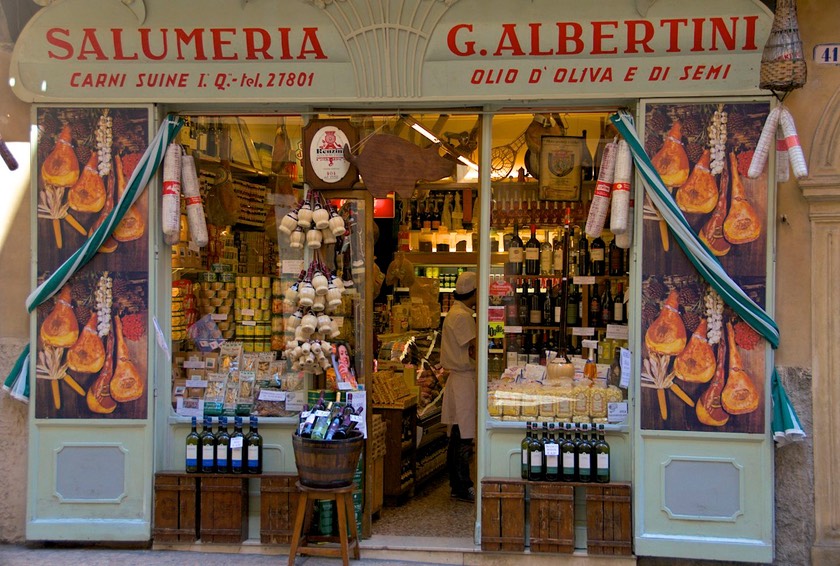
We have returned to the flatlands from time to time.We had left Mantua on a Wednesday, in a hurry to get out of the heat, and went back on Friday to finish seeing the rest of the city. Rick had the Tazio Nuvolari Museum in mind, which was only open on the weekend, for one thing. We spent a delightful Friday afternoon wandering around. Everybody was elsewhere and we had the piazzas to ourselves – hot countries really do shut down in the afternoons. We know they think we’re crazy (mad dogs and Englishmen and all that), but it sure makes it a good time to see a city. On Saturday, Rick had a nice visit with Tazio’s memory, stopped at the market to buy bread (by the kilo) and we went on towards Verona.
We spent Sunday in Verona and it was a treat. It’s a terrific, picturesque city – and the setting for Romeo and Juliet’s storied romance. Must say the city goes a tad overboard on the romantic connections to this after all fictional love story, but let’s give them their due; nobody gets hurt and it really is kind of fun to go past “the house where…” or “the bridge…” or, well, you get the picture. The city is well worth the effort to visit at any rate.
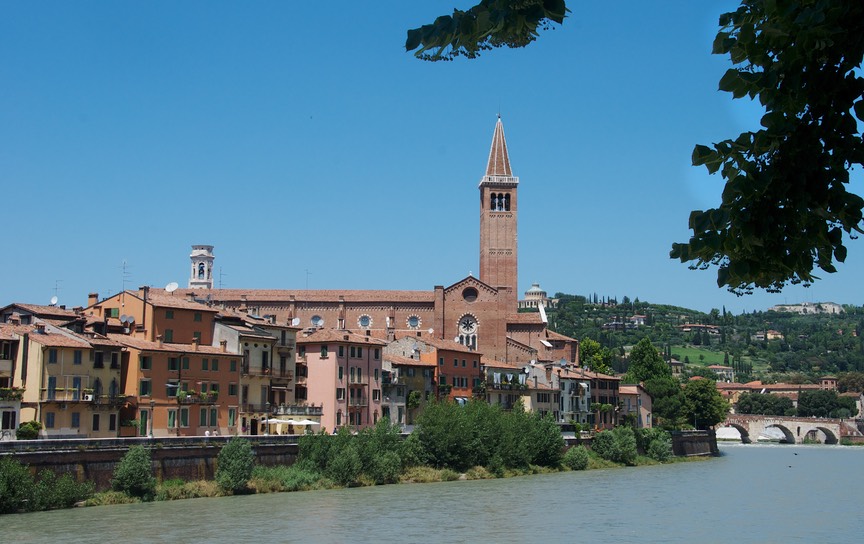
We trooped all over the old city and back and forth across the bridges over the river, having a very good time. But the most fun was that there was a Norwegian band festival going on (who knew?), with each group of kids and adults marching through the streets and stopping to play from time to time. They were so earnest, and so cute; it was great.
Our next journey down out of the mountains was to visit Cittadella, and Treviso, nice small medieval towns with some great fortifications. Treviso also has a Duomo that has a cool crypt, but they wouldn’t let me down into it because of other activities, so ho hum. We enjoyed ourselves anyhow. These towns are close to Venezia, and this whole area has been constructed on a grid system coinciding with canals; we presumed the waterways were there to help drain the Veneto, which is what this region is called.
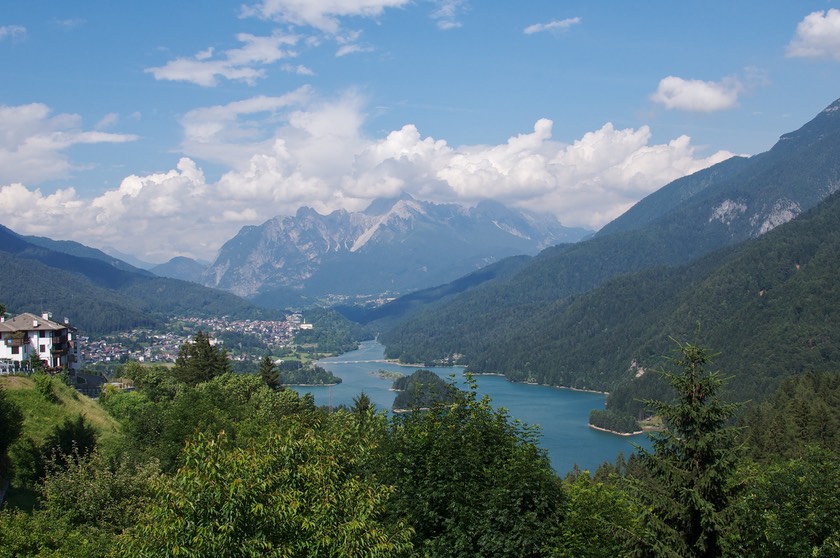
But we’ve been happiest in the mountains. Typically we’re between 3,000-5,000 feet in elevation. Every night we park up where we can hear the church bells of the nearest village, most of them incredibly lovely and deep. On Sunday mornings folks come for mass, walking or driving or riding their bikes. Cows (and cowbells) are often near, the mountain streams are full, cuckoo birds keep following us, and it rains regularly (usually in the night), keeping everything cool and moist and generally with a little thunder and lightning thrown in just for fun.
We’ve stayed on the smallest roads we could find, enjoying the reduced traffic and un-touristy villages. Occasionally, we’ll turn a corner in the middle of nowhere, and oops there’s a sign saying the road is closed ahead. So we turn back, try another squiggly little line on the map, and slowly make our way eastward. We share the road with cyclists and motorcycles and the Italian version of the Cushman truck – the Piaggio – 3-wheeled, narrow, and very useful on these difficult roads.
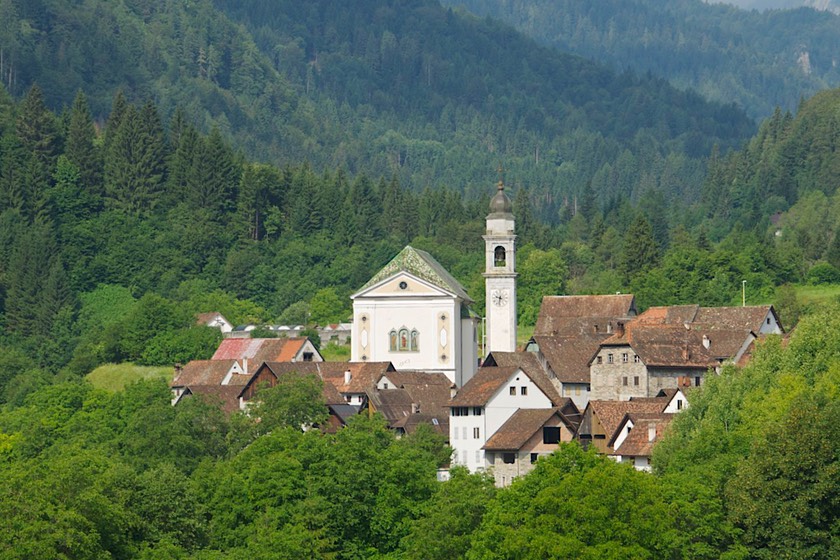
Shopping has been a bit scarce, but we manage. One fly in the ointment of planning to visit cities on the weekends is that almost without exception the grocery stores close early in the afternoon on Saturday and don’t reopen until Monday morning. Careful planning is required (us? “careful planning”? hah!)
One of our favorite mountain spots was a grassy meadow near a ski resort. There was a resident herd of cows, along with 4 lovely palomino horses, and a crew loading logs onto a series of trucks. Very bucolic.
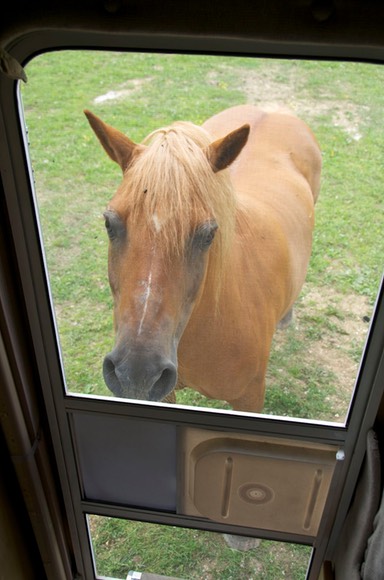
The animals quickly decided we had to be the Burrito Wagon, or whatever cows call their favorite snack truck, and regularly they would surround us, waiting for someone to throw them some hay or whatever. They’d lick the sides of the coach, itch their scratches on either the front spare tire or the back aluminum boxes, chew on the rear view mirrors, leave saliva trails on the windows and poop. Mostly poop. They finally got to be enough of a nuisance that we left – after most of three days. We do have staying power when we want to!
Naturally, we’ve done some sightseeing while in the mountains. Asiago (not too far from the itchy cows) has a large war memorial, which we visited. There was plenty of fighting in these mountains, during both world wars. Italy was always in it, always fighting to redress some earlier insult, the townspeople suffering mightily. The town of Feltre gave us a good chance to visit a medieval fortress town that was heavily bombed during World War II. Terrible, terrible times.
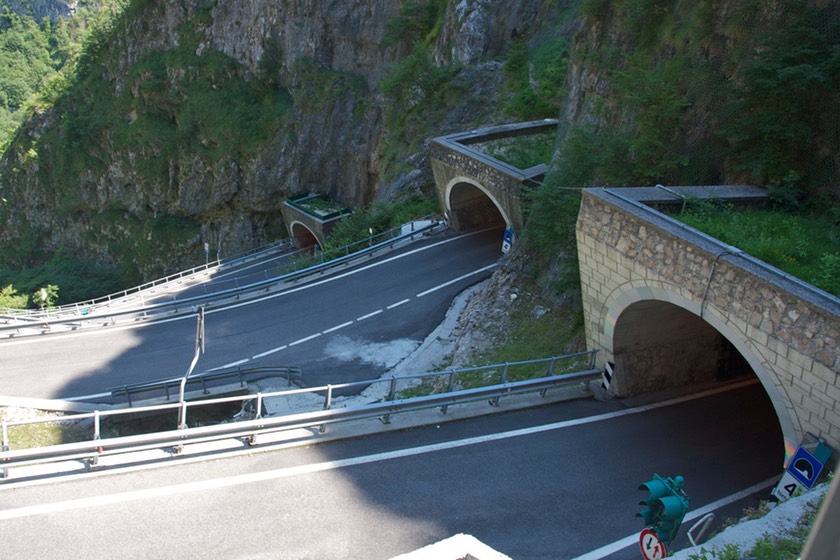
One night we ended up parked in the lot for the local cemetery, high up a very difficult pass. This had been a bit of an adventure. We had taken a small road over the pass, the Paso San Boldo, on a whim. A little ways up we started seeing signs about a 3.0 meter height limitation ahead. This difficulty turned out to be a series of very small, very twisted, very quick one-way tunnels. We didn’t have any problems, but they were low and narrow, and actually U shaped, going into the mountain and then doubling back to come out again at a higher level – amazing! In the picture, we went in the bottom opening, then did a hairpin turn inside, coming out through the middle opening, before doing another hairpin and reentering the tunnel through the top entrance; this continued for a total of five tunnels. We managed to negotiate them okay, and fortunately the traffic is all one way and controlled by lights, but it was a bit hairy. We found out the road had been constructed during WWI under duress, by old men and women and children and prisoners of war, forced to do so by the occupying Austrians; it was completed in 100 days. It has 18 hairpin turns (tornatos the Italians call them – and they like to number them, too) and 5 of these nasty little tunnels. It was quite something.
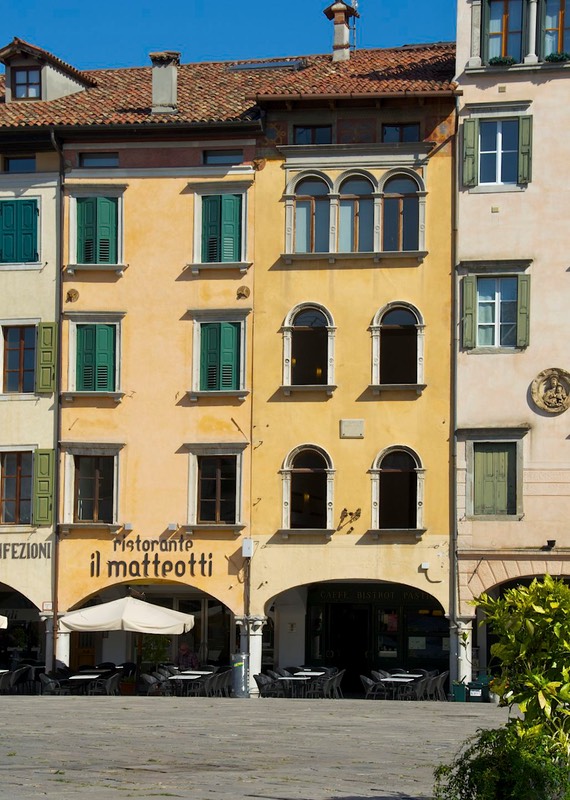
Well, that night we were in this parking lot. In the morning a monstrous truck pulled in (it had come up the other side, not through the tunnels!) and the fellow proceeded to start to unload all his equipment, which was for a road project starting up around the corner. We were concerned about being in his way, but he grinned and said “Tutti okay.” It’s been our motto ever since!
Nearing the Slovenian border, and waiting for mail, we checked out the city of Údine, with a fine collection of Tiepolo frescoes housed in a building guarded over by the most charming ancient Italian gentleman we’ve ever met. He was so sweet that even when he told us we couldn’t take pictures inside the Palazzo, we couldn’t get upset with him. I wish we’d been able to get his picture.
Cividale del Friuli is a medieval town with a very nice post office. It’s near Údine, and is where our mail will, eventually, arrive. Fortunately, it’s also a real charmer, and we’ve enjoyed wandering around the small village seeing the sights, including a lovely Duomo and central piazza. Unfortunately, we’ve been around while a long-lasting cultural festival has been underway, and the big outdoor stage and tiered seating has remained smack-dab in the middle of it all. A common sight in the summertime in Europe.
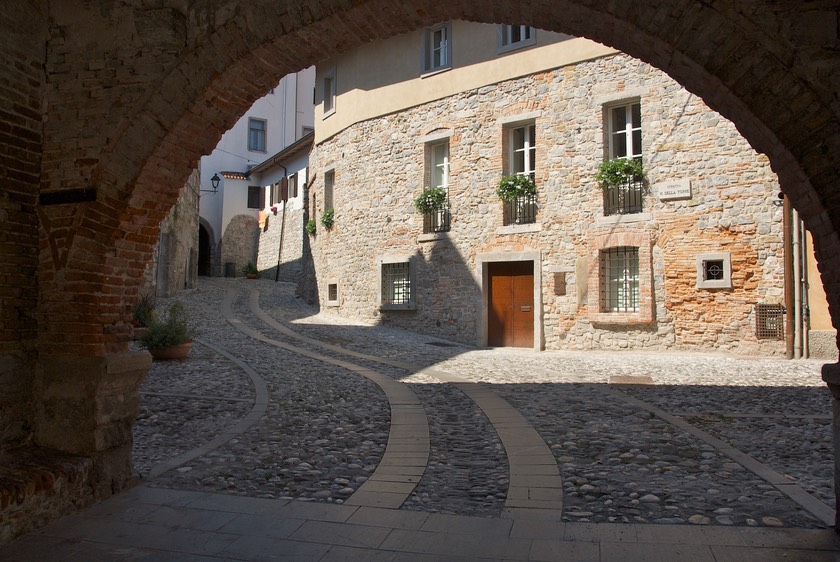
Aside from adventures, mostly we’ve been preparing for our summer in the Balkans. This will be a bit of a departure from our recent experiences. Fewer folks travel there, particularly in areas like Macedonia and Albania. So we’re scrambling for resources on where to stay, what to do about fuel and propane, what are the border situations, etc. Yes, Virginia, after Slovenia, these are countries that are not in the EU; they actually have border crossings.
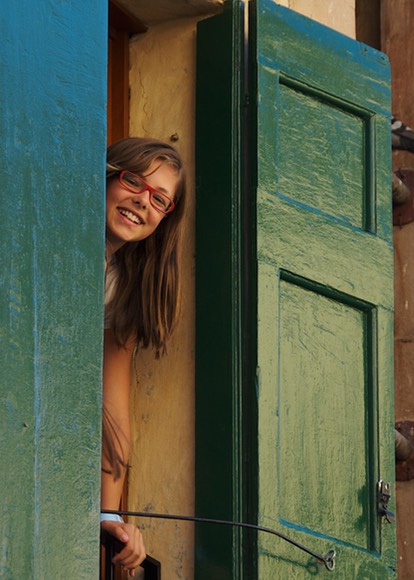
One country we’d like to visit is Kosovo, which declared its independence from Serbia just three years ago. As Serbia does not recognize the separation, we’re trying to find out whether or not a visit is a good idea these days. So we’ve had lots to do while we’ve waited for the mail.
Well, some of the mail has come. How long do we wait for the rest? Not forever, that’s for sure. Not even Godot is worth that much time. So, on to Slovenia. We’ll be back with our Second Italian Campaign next spring. Current plan is to start at the boot and work our way north; hoping to avoid the summer heat and the worst of the tourist swarms; sound familiar?
Stay cool, and think of us sweltering in Serbia (hmmm – sounds like a great title for a movie).
Love ya all; Rick and Kathy and Tortuga the Intrepid
Click to see more photos from Northern Italy